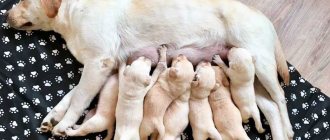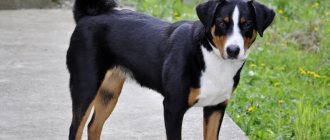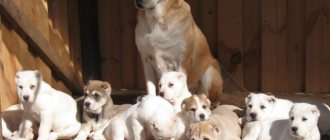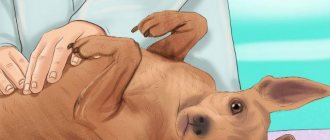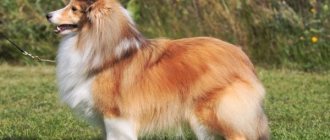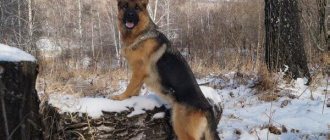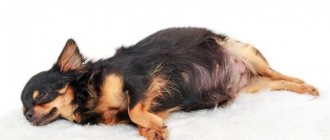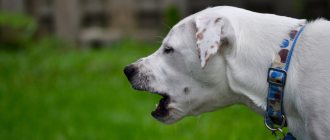Pregnancy and childbirth
Spaniels become physically mature at the age of 24-30 months, but the first mating can be done a little earlier, since puberty of these dogs usually occurs before they reach 2 years of age.
Animals intended for mating require a special regime and diet. 1-1.5 months before the day of the planned mating, spaniels should definitely be given antihelminthics, but only on the recommendation of a veterinarian. The composition of food for purebred male dogs should include vitamins A, E, group B, proteins, and microelements. The diet also includes raw meat, fish, eggs, dairy products and vegetable oil.
A few days before mating and for a few days after it, male spaniels must add 1 teaspoon of vegetable oil and 5-6 drops of vitamin A to soups or porridges daily. To compensate for the deficiency of calcium in the dog’s body, as well as other necessary substances, it is recommended to periodically introduce mineral supplements into the main food.
The interval between estrus in a female dog is 6-7 months. You need to know that bitches are mated for the first time only after their third heat. If the next heat does not occur on time, this is most likely due to a lack of animal protein in the dog’s body. The dog owner should contact a veterinarian if the spaniel bitch's first heat does not occur when she reaches one year of age. A doctor’s advice is also necessary if you plan to use a bitch older than 4 years of age for mating.
Mating should be carried out twice, the optimal interval between matings is 1 day. In this case, the egg retains the ability to fertilize for 4–5 days.
A female dog's heat begins with the appearance of bloody discharge from the genitals. The loop (external genital organ) greatly increases in size at this time. The owner must accurately record the day of the onset of estrus so that there is no error in determining the onset of ovulation (the time when an egg is released from the ovaries, ready for fertilization). In spaniels, the ovulation period occurs on days 11–14, that is, at the end of the second week of emptying. It happens that the timing of ovulation shifts in one direction or another. To determine the most accurate day of ovulation, you usually contact a veterinarian who performs a smear analysis.
The most favorable day for mating is the last day before ovulation begins. On the eve of the release of the egg from the ovaries, bleeding stops in bitches, sometimes the discharge remains, but is colorless or light pink. 1-2 days before the most suitable day for tying, the loop loses its elasticity and remains tight only in the upper part. The bitch's readiness for mating is also determined by the position that the dog takes if you run your hand over its croup and lower back: it squats without touching the ground with its backside, and lifts its tail, moving it to the side.
Knitting methods
There are two methods of mating when crossing dogs - freestyle and manual. If this is not the first time a male dog has been used for mating, freestyle mating is recommended. However, it is very important that the spaniel bitch has an increased interest in him. But even in such cases, complications during the mating process are not uncommon. Therefore, the owner must be nearby, for example, to prevent the bitch from rushing to the side while the dogs are in the castle, as this can lead to injury to the dog. To exclude unforeseen and undesirable situations, invite an experienced breeder to be present at the mating, especially if the breeding of a dog or bitch is being carried out for the first time. In the case where dogs are assisted throughout the entire mating process, such mating is called manual mating.
Spaniels retain the ability to reproduce offspring into old age, but you should not expect the birth of strong and healthy puppies from old individuals.
At home, male dogs, as a rule, feel more independent, calm and confident, so experienced breeders advise bringing a bitch to a male, and not vice versa. Before mating, care must be taken to protect the dogs from any stressful situations, otherwise they will behave restlessly, which will negatively affect the crossing process. Hygiene standards must also be observed: before mating, the bitch’s genitals must be washed with an aqueous solution of rivanol. Feeding dogs (both males and females) should be done no later than 3 hours before mating, after a walk.
How the acquaintance period goes depends on the character of the dogs. In some cases, males immediately begin to mount, in others they begin to lick the bitch and do several test mounts before mating. If the male is much larger than the female, he needs help to mount. The owner is recommended to lift the bitch's body by placing his knee under her belly. At this time, the dog is held by the hand on the lower back. The owner of the bitch must also help his dog by holding it by the neck.
Owners should under no circumstances show concern when their dogs are unsuccessfully boarded. Nervousness will certainly be transmitted to your pets, and they will experience tension as the mating process continues. To avoid overfatigue and overexcitation, animals must be periodically provided with rest for 10-15 minutes. At this time, it is advisable to take the bitch to another room.
When helping dogs with mating, that is, holding a male on a bitch, you must not touch the male’s genitals, otherwise he may refuse to mate. To facilitate the mating process, the bitch's loop is usually lubricated with Vaseline.
The fertility of a bitch is a hereditary factor, independent of the number of matings and the amount of sperm secreted by the male.
It is believed that mating goes well if the male spaniel’s penis is tightly compressed by the bitch’s vagina and the dogs are in the lock for 5 to 20 minutes (sometimes for 1 hour), and separation occurs arbitrarily. If the lock does not work out, then the mating is repeated a day later.
In some male dogs, at the end of mating, the tension of the penis does not decrease; it remains enlarged and does not enter the prepuce. In this case, it is recommended to use cold lotions or wash the genitals with cold water. When bending the edges of the prepuce inward, you should carefully straighten them with your fingers.
After mating, dogs need a short walk and proper rest.
Pregnancy period
After a successful mating, the spaniel bitch becomes pregnant, which lasts about 9 weeks. It happens that birth occurs prematurely or the gestational age increases to an average of one week. But there is no cause for concern yet, the dog owner just needs to prepare in advance for childbirth and provide skillful assistance to the pet during childbirth. Then the probability of the birth of healthy offspring will be as high as possible.
Before the dog’s fourth week of pregnancy, there is still no need for a special regime and diet, since the growth and development of the fetus is poorly expressed. But we must remember that during this period the dog’s susceptibility to infectious diseases increases. Along with this, a negative reaction to chemicals and medications develops. Therefore, throughout the dog’s pregnancy, the use of antiparasitic and other drugs should be avoided.
The diet of a pregnant bitch must contain enough minerals, especially calcium. The daily calcium intake during the first month of pregnancy should be at least 65-70 mg per 1 kg of dog’s body weight, because a significant part of the calcium will be used by the body for the normal development of the fetus. Phosphorus in food during the day should be at least 50-55 mg per 1 kg of animal body weight. You can give calcium gluconate or calcium glycerophosphate in tablets or powders, and it is better to feed calcium gluconate along with phytin tablets, which promotes the proper formation of bone tissue in fetuses.
Your dog should consult a veterinarian at the beginning of the fifth week of pregnancy. At this time, you can already determine the number of fetuses by carefully feeling the bitch’s belly. It is not advisable to do such probing in the future. The movement of the fruits begins in the eighth week, at the same time the heads are formed.
If the onset of pregnancy occurs in winter, then vitamin supplements must be introduced into the dog’s diet. This applies primarily to vitamins A and D, as well as drugs recommended by experts such as tetravit and etravit. Contact your veterinarian and he will correctly calculate the dosage of vitamins and minerals for your dog.
From the fourth to the sixth week, a pregnant dog is given 3 meals a day. The daily food intake should be significantly increased by adding meat, fish products, cottage cheese, as well as milk soups and porridges to the diet. At this time, the daily dose of minerals necessary for the animal almost doubles. In the second half of pregnancy, the owner must provide a reduction in carbohydrate foods for the dog and introduce feeding in the form of pureed raw vegetables and fruits. In the period from the 30th day until the end of pregnancy, it is very useful to add bone meal (2 tablespoons daily) and vitamin A (5-6 drops) to food.
Remember not to overfeed your dog. Sudden weight gain can complicate childbirth.
In the last three weeks of pregnancy, overly active, active games should be excluded from the dog’s daily routine. Provide her with a gentle regime during this period. But the duration of walks should remain the same. An exception may be those cases when the dog is very tired from being outside. You can replace two long walks with several short ones.
Starting from the eighth week, the dog needs to be fed 4 times a day. Eliminate bones and all foods that impede intestinal motility from her diet. Leave the amount of minerals introduced the same. It is advisable to replace the meat with boiled sea fish (150-160 g of fish corresponds in calorie content to 100 g of meat). This will be a reliable obstacle to the development of toxicosis (eclampsia) in the dog.
During the second half of pregnancy, be sure to regularly examine the bitch's anal glands. If you have any genital discharge or inflammation, contact your veterinarian immediately. If your dog is allergic to vitamins or minerals, it is necessary to reduce their amount in the diet.
You can tell about the onset of labor by looking at the nipples of a pregnant dog. On the eve of childbirth, the nipples enlarge, and when they are slightly squeezed, a whitish liquid is released - colostrum.
In the last days before giving birth, walk your dog briefly but often. Go home as soon as you notice your dog is tired; do not overtire him. Frequent walks are also necessary for the reason that before giving birth the bitch has to urinate frequently. Starting from the seventh or eighth week of pregnancy, the dog should not run, jump on a barrier, swim in bodies of water, or participate in active games.
In the last week of pregnancy, the amount of food consumed by the dog during the day must be reduced by 1/4. Give her food 5-6 times a day in small portions.
Childbirth period
A week before giving birth, give your dog a place in a warm, clean, dry and comfortable room where there are no drafts. Only her owner can enter the room where the bitch is before giving birth. Strangers should not disturb the animal before childbirth and in the first days after its completion. It must be remembered that a bitch who has become a mother often shows aggression towards strangers, protecting her newborn cubs. After the puppies are born, it is advisable to leave them in the same room for another 2 weeks.
The dog will be comfortable giving birth in a specially made wooden whelping box that fits its body size. The puppying bitch will be able to rest her paws against its walls. Try to make the front wall folding or removable. This will make it easier for you to disinfect and clean the delivery box.
Before birth, cover the bottom of the box with plastic wrap, tarpaulin or oilcloth. Place a piece of old blanket or soft cloth folded in several layers on top of the waterproof bedding. A week before the expected day of birth, regularly measure your dog’s temperature 2 times a day. A temperature of 38.5° C is considered normal, but about a day before the onset of labor there is a decrease in temperature to 36.5-37° C. According to the observations of dog breeders, in the last week before giving birth, bitches are characterized by loss of appetite, so feed her food in small portions , attracting the dog with its most favorite treats - a piece of boiled liver or cheese, etc.
In the last days before your dog gives birth, exclude meat and all foods that cause allergic reactions or disgust from her diet.
Particular attention should be paid to regular bowel movements of the dog. Be sure to contact your veterinarian if you notice a change in the color of the stool and the presence of a sharp, unpleasant odor, or if more than 24 hours pass after the temperature drops and the dog does not experience contractions. A very high temperature before birth (more than 39° C) should also cause concern for the dog owner: in this case, there is a high probability of an unfavorable course of labor and the birth of still puppies.
Childbirth in a bitch can take place without the help of the owner, that is, naturally. However, the dog owner must be nearby and monitor the progress of the birth. It happens that childbirth goes well, but the presence of the owner and his help are still necessary. During a difficult birth, a dog experiences various complications. In this case, you should invite an experienced veterinarian.
Before labor begins, you need to prepare everything you might need to monitor your dog's condition and for delivery care. On hand you should have clean, dry pieces of gauze and ironed towels, a room thermometer to monitor the air temperature in the whelping box, a large hard cardboard box for puppies, scissors for cutting the umbilical cord (preferably with rounded ends), a bottle of alcohol for hand disinfection , syringe, iodine, cotton wool, scales for weighing puppies, Vaseline, thick strong white thread for pulling the umbilical cord, ampoules with oxytocin (if necessary, this drug is administered to stimulate uterine contractions), colored wool threads for marking puppies, a large piece of oilcloth or tarpaulin, a notepad and pen for taking notes about the newborn puppies.
The room where the birth takes place should be warm enough. You can raise the temperature using a heater or electric lamp installed near the delivery box.
It is advisable to make a special overall for the dog for the postpartum period in order to protect the nipples from contamination. It is also useful for walking a nursing dog in winter.
Be sure to place a bowl of fresh water near the delivery box, the cleanliness of which must be constantly monitored.
In addition to the above, prepare a solution of potassium permanganate with a concentration of 1:1000 and warm soapy water. It will be needed to alternately wash the external genitalia, perineal area and croup of the dog before the onset of labor. If you provide the necessary assistance to your bitch, pay attention to the cleanliness of your hands. Wash them with warm water and soap and treat them with a cotton swab dipped in alcohol. Fingernails should be neatly trimmed.
You can recognize the onset of labor in a dog by the following symptoms: the dog is worried, refuses food, its breathing quickens and its muscles tremble. The mammary glands noticeably enlarge. The dog scratches its paws on its bedding in the box, trying to make itself more comfortable in it. If the bitch lies down on the bottom of the box, then when examining her belly you can notice the movement of the fetuses.
The process of childbirth in a dog consists of three main stages: preparatory, gestation and postpartum. At the preparatory stage, the muscles of the uterus contract, contractions begin, then the cervical canal opens upon contact with the amniotic fluid. This period usually lasts from 6 to 24 hours, sometimes up to 28-30 hours.
After the cervical canal has fully opened, the stage of fetal excretion begins. Then the contractions are already accompanied by periodic contractions of the abdominal muscles - pushing. The fruits alternately move along the birth canal and begin to emerge. In dogs, both cephalic and breech presentation of fetuses occur: in these cases, childbirth, as a rule, proceeds quite normally. The amniotic sac ruptures either while the fetus is passing through the birth canal, or after the birth of the puppy. The mother usually gnaws the umbilical cord herself and carefully licks the newborn puppy, removing any remaining mucus and scraps of the amniotic sac.
There is an opinion among experienced breeders that there will be exactly as many puppies in a litter as the number of hours the dog goes into labor, provided that the birth proceeds without complications.
Some dog breeders believe that it is advisable to use oxytocin injections to stimulate labor, but this drug should not be used without consulting a veterinarian, because uterine rupture may occur under the influence of oxytocin, which intensifies natural contractions.
After the birth of each fetus, an afterbirth is released, although in some cases this may occur after the birth of the next puppy. As a rule, the bitch eats the afterbirth, but it also happens that due to birth shock, the dog can eat newborn puppies. Therefore, the dog owner observing the birth process needs to be extremely careful in order to preserve the offspring.
If your dog has multiple births, you need to ensure that she only eats one or two of the entire placenta. “Overeating” in this case can lead to disturbances in the dog’s gastrointestinal tract, and it will experience severe diarrhea.
Hatching occurs within a few hours, depending on the number of puppies. Puppies are born 10-20 minutes apart, but sometimes the time between their births can be longer. It is considered that the labor process is completely completed if 2 hours have passed since the birth of the last fetus. Now you can inject your dog with oxytocin to facilitate the process of expulsion of the placenta after the birth of the last puppy. Your veterinarian will help you calculate the dose.
In the postpartum period, the dog experiences greenish or reddish discharge from the genitals, then it becomes lighter and disappears completely after 2 to 3 weeks.
If during childbirth the mucous membrane of the birth canal remains dry, which makes the birth process difficult, inject petroleum jelly with a syringe or rubber catheter, or lubricate it with petroleum jelly using a cotton swab.
There are times when newborn puppies may need your help. Sometimes the mother after giving birth seems completely indifferent and makes no attempt to take care of the babies. This happens when the birth process goes too quickly or, conversely, drags on for a long time and the dog is very tired. The same can happen during the first birth. What should be done?
If the dog has not freed its babies from the membranes, you can do it yourself by quickly and carefully breaking the membranes on the head of each newborn spaniel and clearing its body of mucus. For this purpose, you will need small gauze swabs.
Clearing the baby's mouth and nose of mucus is necessary to prevent it from entering the respiratory tract, which often causes suffocation and death of the puppy.
To avoid the development of a hernia, you should not leave a very long umbilical cord. Its dressing should be done 2 cm from the puppy’s abdomen. The thread for dressing is thoroughly disinfected. The umbilical cord is cut just below the ligation site. After this, each puppy should be dried with a clean towel. After a few days, the umbilical cord dries out and falls off.
Umbilical cord ligation
If your puppy has difficulty breathing, take him in your hands and, holding the baby's head with your fingers, quickly shake his body several times from top to bottom. In this way, you will help clear the puppy’s airways of all remaining mucus, and his breathing will quickly recover. It is also recommended to massage the newborn puppy by gently pressing the rib area with your palm to stimulate breathing. If this does not help, you can wet the back of his head with cold water, then massage again and vigorously rub the baby’s entire body with a piece of dry soft cloth or a towel.
When, after carrying out all the necessary hygiene measures, you are convinced that the puppy’s breathing has become normal, you need to feed him. First massage the mother's nipple until traces of colostrum appear on its surface, and only then attach the newborn to the nipple. After the baby has eaten, place him in the prepared box, after wrapping him in a piece of warm soft cloth. Do the same with each puppy that is born. The box where the puppies will be placed should be positioned in such a way that it is clearly visible to the mother. Thus, the birth process will simultaneously be combined with the first feeding of the puppies, and this is a very favorable moment for the giving birth bitch.
Newborn puppies should be applied to their mother's nipples one at a time. First one will eat, then the next one, etc., so that a fierce struggle for survival does not begin between the kids.
It happens that colostrum is not produced during birth, then you will have to feed the puppies yourself. To do this, you will need a pipette or pacifier, and the newborn only needs a few drops of milk. Usually this is goat milk or powdered milk dissolved in water.
After the last puppy is born, the bedding in the box must be changed. After giving birth, give your dog activated charcoal to avoid gastrointestinal upset from the placenta she ate.
Newborn massage
If the intensity of contractions of the muscles of the peritoneal wall decreases during the birth process, they decrease or disappear, feed the dog to give it strength. For this, specially cooked meat broth and warm sweet tea with milk are usually used. However, we must remember that the volume of liquid consumed by the dog should be moderate, otherwise the bitch’s milk secretion will be too abundant, and newborn puppies will not be able to suck it out completely. In addition, the dog’s risk of developing mastitis – inflammation of the mammary glands – will increase. The dog owner should be alarmed by such symptoms as high body temperature, inflamed and hardened nipples, reddened skin of the mammary gland, and the appearance of purulent discharge on the surface of the nipple when it is slightly squeezed.
Constant monitoring of the condition of the nipples and mammary glands is necessary both during childbirth and in the postpartum period. The nipples should not be hot or hard to the touch; puppies can only take a soft nipple. If you suddenly notice that your nipples have become hard, be sure to massage them, express some of the released milk, and then apply it to your baby's nipple. In the future, make sure that the puppies suck milk from all nipples, and that the nursing dog exposes one side or the other to the babies.
If complications arise during childbirth that you cannot cope with on your own, urgently call a veterinarian at home.
After a normal birth is completed (that is, after the last placenta is released), the dog must be taken out into the fresh air. After each walk, wash the bitch's external genitalia with warm water and then dry them with an ironed soft cloth. When the dog feeds the puppies, your job is to make sure that none of the babies go hungry. Do not forget to feed the bitch 7-8 hours after the end of the birth process.
Maintenance of a dog and its offspring during the postpartum period
As mentioned above, in the last weeks of pregnancy and during childbirth, a dog may experience eclampsia - late toxicosis. Characteristic signs of the disease include severe swelling, increased blood pressure, kidney failure and seizures. If toxicosis has begun, the dog urgently needs help from a veterinarian.
There is also such a specific disease as postpartum tetany. Every dog breeder should know the symptoms of this disease - rapid heavy breathing, restlessness of the bitch, difficulty in her movements, muscle spasms and trembling, drooling, refusal to eat. The attacks may recur. Despite the fact that in the intervals between them the dog’s condition temporarily improves, with a relapse there is often a sharp deterioration in its well-being. If your dog exhibits signs characteristic of postpartum tetany, you should also immediately consult a veterinarian. Before he arrives, try to keep your dog warm by placing a heating pad on his paws. Give 20–30 drops of Corvalol or Valocordin orally to stimulate cardiovascular activity.
To prevent the development of postpartum complications and diseases, enrich your dog’s diet during pregnancy and after birth with vitamins and minerals; in the last week before giving birth, exclude raw meat from its food, but do not forget to reintroduce this product into the diet a week after birth. If your dog's food during the prenatal and postpartum periods contains enough calcium, your pet will not be afraid of tetany.
During lactation, a dog's diet must contain mineral supplements and vitamins. It is very useful to add crushed raspberry leaves to the main food.
In the first days after birth, preference in your dog’s diet should be given to liquid porridge, boiled sea fish, milk, cottage cheese, kefir, and yogurt. After three days, feeding with soups cooked in meat broth, rice and oatmeal is allowed. You can also give small portions of chicken and boiled beef.
Remember that walks with your dog should not be long; take your dog out only when necessary. When you return home, pay attention to the cleanliness of her paws.
The likelihood of mastitis is very high, so you need to regularly check for cracks in the nipples. For prevention, they should be treated with a weak solution of potassium permanganate. If cracks do appear, they should be immediately lubricated with syntomycin liniment and covered with an antiseptic bandage.
In the first two postpartum weeks, the dog should be fed at least 4-5 times. From the second week, raw meat products are introduced into the bitch’s diet.
Starting from the third week after birth, the dog is given bone meal, raw fruits and vegetables, 2-3 tablespoons of tomato juice daily and vitamin C, 1 tablet per day. It is necessary to continue feeding your dog vitamins and mineral supplements regularly. Ensure that your dog has adequate calcium in his diet. If you find it difficult to correctly calculate the daily intake of nutrients, your veterinarian will help you with this. The need for a nursing dog is influenced by the number of puppies born, the body weight and well-being of the mother. Three weeks after giving birth, the dog's food should still be predominantly liquid (soups, cereals, cottage cheese with milk), since liquid food promotes lactation. Adding 2 teaspoons of chopped walnut kernels 3 times a day and 1 teaspoon of honey dissolved in 2 glasses of milk to the bitch’s food will help increase the amount of mother’s milk.
From the fifth to sixth week, the amount of liquid consumed by the dog should be reduced so as not to cause excess lactation. Reduce the number of feedings at this time to 3-4 times a day.
During the same period, you should treat the dog’s nipples with camphor oil several times a day, combining this with a light massage. Usually 1-1.5 months after the birth of the offspring, the dog begins to shed. During this time, try to carefully care for its coat and comb the dog with a comb twice a day.
A month and a half after giving birth, you can gradually increase the duration of your pet’s walks and the amount of physical activity.
If a bitch's birth canal becomes infected during childbirth, puppies may die from sepsis in the first days after birth. These are usually the first born puppies, while the last ones are usually born healthy. In this situation, it is necessary to immediately isolate the babies, transfer them to artificial feeding, or place them on another nursing bitch. Call a veterinarian for a sick mother.
In the first week of life, babies need to be applied to the nipple 12 times a day, in the second week - 8 times, in subsequent weeks - 4-5 times a day. Always monitor the cleanliness of the box where the babies are kept, change the bedding in it daily. Starting from the second week of life, the claws of the puppies' front paws are carefully trimmed so that they cannot injure the mother's skin during feeding.
If there are more than six puppies, and the bitch’s lactation is insufficient, the puppies should be given additional formula from cow’s or goat’s milk. But this can only be done when the puppies reach 2 weeks of age. To feed puppies, use a bottle with a nipple.
To properly prepare formula, take 1 glass of warm cow's or goat's milk with 2 teaspoons of milk powder dissolved in it. You can only use powdered milk, stirring it in warm water (for 0.5 liters of water - 200 g of milk powder). You can add one raw egg yolk to the milk mixture. The amount of complementary feeding depends on whether the puppies have enough mother's milk: if yes, then they are fed with formula three times a day, if not, then the number of artificial feedings is increased to 6 times a day.
Two-week-old puppies can already move independently. They try to crawl out of the box, walk unsteadily at first, and then run around the room. Therefore, the floor should be covered with a fleecy blanket or cloth so that when walking, the puppies’ paws do not slip and move in different directions. This will be a good prevention for the development of hip dysplasia.
At 3-4 weeks of age, puppies begin to feed on their own. Before weaning babies from their mother's nipples, they need to be taught to lap up milk from a saucer. Move the saucer of milk towards the puppy and gently poke his face into it. If he doesn't succeed, dip your finger in the milk and let the puppy lick it.
After the puppy learns to lap milk from a saucer on its own, nutritious foods such as egg yolk and fresh wheat bread crumbs should be added to the milk. Liquid semolina porridge with milk is very useful for puppies. One chicken egg yolk is added to it. For milk porridges, in addition to semolina, you can use other cereals, but they should first be ground in a coffee grinder.
From 3 weeks of age, puppies are already given cottage cheese and fed with lean, scraped raw meat (the daily norm is 1/3 teaspoon). For babies aged 4 weeks, the amount of raw meat is doubled and given not scraped, but finely chopped. In the fifth week of life, puppies receive meat in complementary foods 3 or 4 times a day. The norm should be increased gradually: from 20 g to 50 g for a 3-week-old puppy and from 100 g to 200 g for a 4-week-old puppy.
Children need vitamin supplements every day. Add 2 drops of vitamin A and 2 drops of vitamin D to the milk mixture prepared for all puppies together. This norm should not be exceeded to avoid an overdose of vitamins.
Introduce each new food for your puppy into the diet carefully and gradually, in small portions. If the baby does not tolerate a particular type of food, it should be excluded from the diet.
Starting from 3 weeks of age, puppies, in addition to milk, must be given fresh water to drink. For each baby, two bowls should be prepared: for food and for water. During the same period, mineral mixtures are introduced into the puppies’ diet.
Remember that at the first sign of any disease, puppies should be immediately taken to the veterinarian. Under no circumstances should you treat children yourself - this could cost them their lives.
Until puppies reach 5 weeks of age, they are fed at least 6 times a day, then at least 5 times a day, maintaining equal time intervals between feedings.
Until the moment when the puppies stop feeding on their mother's milk, they should constantly receive the following products as supplementary food: boiled goat or cow's milk, cottage cheese, chopped raw beef, egg yolk, butter and vegetable oil, oatmeal and rice broth, oatmeal, rice , semolina and buckwheat porridge from cereals ground in a coffee grinder, finely grated potatoes, carrots, beets and other vegetables.
If there are disturbances in the activity of the puppies' gastrointestinal tract (constipation, diarrhea), it is necessary to find out the cause of their occurrence and, if necessary, change the puppy's diet: add new foods or replace some foods with others. If the puppy has diarrhea, drop a few drops of a weak solution of potassium permanganate into the puppy's mouth using a pipette. Water rice broth also works effectively in this case. A decoction of dill seeds is used against constipation.
The room where puppies are kept should always be dry and warm. The room can be additionally heated with infrared electric lamps, and you can also use heating pads with warm water.
Book title: American Cocker Spaniel
Giving birth to spaniels: proper preparation
It is most convenient to give birth to spaniels on a sofa or on a bed covered with oilcloth and an ironed sheet or absorbent diaper. The nest in which the cocker will feed the offspring and sleep must be prepared during pregnancy, a week before the puppies appear. You can install a large cardboard box, raising it above the floor by at least 10 cm to prevent hypothermia and exposure to drafts;
Childbirth in dogs is a process that can last from several hours to days. To facilitate their passage, the emerging cubs are placed in a separate small box until the process is completed. It is important to ensure the correct temperature regime: from the first to 10-12 days the temperature is kept at 28° C, then it is gradually lowered to 20° C.
We suggest you familiarize yourself with: Aquarium frogs, maintenance, care and reproduction
List of items that need to be prepared for the birth of a spaniel so that everything is at hand:
- a stack of clean diapers;
- a basin for collecting dirty diapers;
- oilcloth;
- electric heating pad;
- thermometers - room and veterinary;
- 2 packs of sterile gauze wipes;
- tweezers, pipettes, scissors - sterilized in boiling water in a container covered with a lid for at least 5 minutes;
- tray;
- small box for puppies;
- syringes of different sizes;
- cotton wool;
- silk threads soaked in advance in alcohol or vodka - for ligating the umbilical cord;
- colored wool threads for marking puppies;
- small scales;
- clock - determine the time of birth;
- pencil, notebook for notes, with phone numbers of veterinarians and clinics in case of force majeure.
Many dog handlers believe that it is better not to interfere with the natural process of childbirth, but cocker spaniels are a special breed that needs the constant presence and support of the owner, as well as qualified veterinary care. The bitch's long hair makes it very difficult to bite the umbilical cord, so be fully prepared - prepare everything you need, trim your nails short, and wash your hands thoroughly.
Read the continuation about pregnancy and childbirth of cocker spaniels (part two).
Moscow
Saint Petersburg
Factors influencing the duration of pregnancy in dogs
Mating errors most often affect conception and the course of pregnancy. Many dog owners believe that a single insemination is enough, but they cannot correctly determine the date of ovulation. As a result, when mating on the twelfth day, due to a shift in the time of ovulation, the dog does not become pregnant. In this case, both the dog and the bitch are checked for abnormal health conditions according to various indicators:
- during the previous pregnancy;
- the number of offspring of a female and a male;
- presence of diseases of the reproductive organs;
- number of refusals to mate;
- during the period of proestrus (estrus);
- hormonal disorders;
- false pregnancies.
The second factor influencing how long pregnancy lasts in dogs is the animals' inability to mate normally. Most often this concerns young, inexperienced male dogs, who, with numerous body movements, cannot completely penetrate inside the vagina, as a result, sperm is poured out in the vestibule of the vagina. Some of the sperm die due to the acidic environment, and the rest are not always able to reach the egg. In this case, pregnancy occurs late or does not occur at all. The third factor influencing how long pregnancy lasts in dogs is poor sperm quality. Poor quality means poor sperm motility, low sperm count and morphology (sperm structure). The amount of sperm directly depends on the weight of the animal and its size. If sperm motility is low or the morphology is poor, the female may not become pregnant or the embryos may die.
We recommend reading: Diarrhea in Shepherd Dogs from Food
